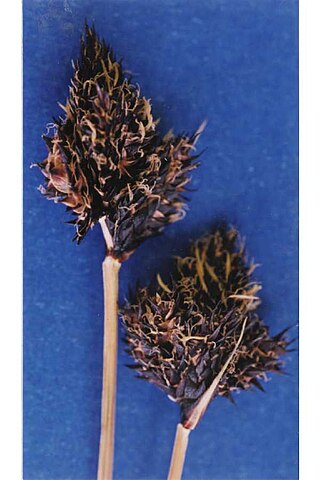
Theridula is a genus of cobweb spiders, found in many parts of the world. Species vary in size from 1 to 3.5 mm in length.

Hume's wheatear is a species of bird in the family Muscicapidae. It is found in Afghanistan, Bahrain, India, Iran, Iraq, Kuwait, Oman, Pakistan, Qatar, and the United Arab Emirates.
Eurysacca is a genus of moths in the family Gelechiidae.

Russula adusta is a species of mushroom. It is a member of the Russula subgenus Compactae. The cap is brown to gray and somewhat shiny, with a mild taste and, reportedly, an odor of empty wine barrels. It has white spores. It can be found growing with conifers. Similar species include Russula albonigra and R. densifolia.

Carex albonigra is a species of sedge known by the common name black and white sedge. It is native to western North America from Alaska and most of western Canada to California to New Mexico, where it grows in mainly dry, rocky high mountain habitat such as talus. This sedge forms a dense clump 10 to 30 centimeters in height with narrow gray-green leaves. The inflorescence is a headlike cluster of overlapping spikes. The fruit is coated in a sac called a perigynium which is dark purple to chestnut brown and often tipped with white.

Actinopyga is a genus of sea cucumbers found in coastal waters in tropical and temperate regions.

Russula albonigra, commonly known as the blackening russula, is a member of the genus Russula, all of which are collectively known as brittlegills. It grows under both hardwood and conifer trees.

Onchidoris is a genus of dorid nudibranchs in the family Onchidorididae. One of its members is known to prey on barnacles and the others eat bryozoans. The radula contains a rachidian tooth when fully developed, but this is vestigial in some species.
Niphadophylax is a genus of moths belonging to the subfamily Olethreutinae of the family Tortricidae.

Pterolophia is a genus of longhorn beetles of the subfamily Lamiinae, containing the following species:
Eurysacca albonigra is a moth in the family Gelechiidae. It was described by Povolný in 1986. It is found in Argentina.

Knoutsodonta is a genus of dorid nudibranchs in the family Onchidorididae. The radular teeth are an unusual shape and a molecular phylogeny study showed that they are not closely related to some other species of Onchidoris within which genus they were formerly placed.
Knoutsodonta albonigra is a species of sea slug, a dorid nudibranch, a shell-less marine gastropod mollusc in the family Onchidorididae.
Pterolophia undulata is a species of beetle in the family Cerambycidae. It was described by Francis Polkinghorne Pascoe in 1862. It is known from Moluccas.
Pterolophia gibbosipennis is a species of beetle in the family Cerambycidae. It was described by Maurice Pic in 1926.
Pterolophia instabilis is a species of beetle in the family Cerambycidae. It was described by Per Olof Christopher Aurivillius in 1922. It is known from Seychelles.
Pterolophia guineensis is a species of beetle in the family Cerambycidae. It was described by James Thomson in 1864, originally under the genus Alyattes.

Choeradoplana albonigra is a species of land planarian belonging to the subfamily Geoplaninae. It is found in areas within the Atlantic Forest in Brazil, such as the Augusto Ruschi Biological Reserve, Desengano State Park, and the municipality of Teresópolis.

Cladonia albonigra is a species of fruticose lichen in the family Cladoniaceae. It can be found as far south as Canada and the United States, and as far north as the Arctic Circle. It prefers acidic soils, and is known to host on trees of the genus Thuja.










